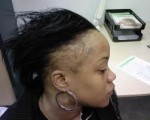 Certain hairstyles such as braids and weaves may increase the risk of a irreversible type of baldness called Central Centrifugal Cicatricial Alopecia (CCCA) that starts at the central part of the scalp and spreads out toward the edge of the hairline.
Certain hairstyles such as braids and weaves may increase the risk of a irreversible type of baldness called Central Centrifugal Cicatricial Alopecia (CCCA) that starts at the central part of the scalp and spreads out toward the edge of the hairline.
Traction alopecia (baldness) is caused by chronic traction (pulling) on the hair follicle and is seen most commonly in African-American females associated with tight braiding or cornrow hair styles. It is generally present along the hairline. Men who attach hairpieces to their existing hair can experience this type of permanent hair loss if the hairpiece is attached in the same location over a long period of time.
 According to a study published in the Archives of Dermatology, "Any style that causes too much tension and traction on the hair....can possibly lead to scarring hair loss." The study included 326 African American women who completed a questionnaire about hair care methods and health status.
According to a study published in the Archives of Dermatology, "Any style that causes too much tension and traction on the hair....can possibly lead to scarring hair loss." The study included 326 African American women who completed a questionnaire about hair care methods and health status.
Nearly 60% of the women showed signs of advanced central hair loss with scarring. Many of these women also had Type 2 diabetes and bacterial infections, suggesting that the hair loss may be related to underlying metabolic irregularities. Women with hair loss should be given an extensive medical workup, especially for diabetes which can be controlled.
Because braiding and weaves are expensive to do, many women keep these styles for an extended period of time adding to the risk of infection. While I personally think these hairdos are often stunning and quite beautiful, most professionals dealing with hair loss advise against them, especially over long periods of time. Braiding for a special event may be okay, but release them in a few days and let your hair rest!
